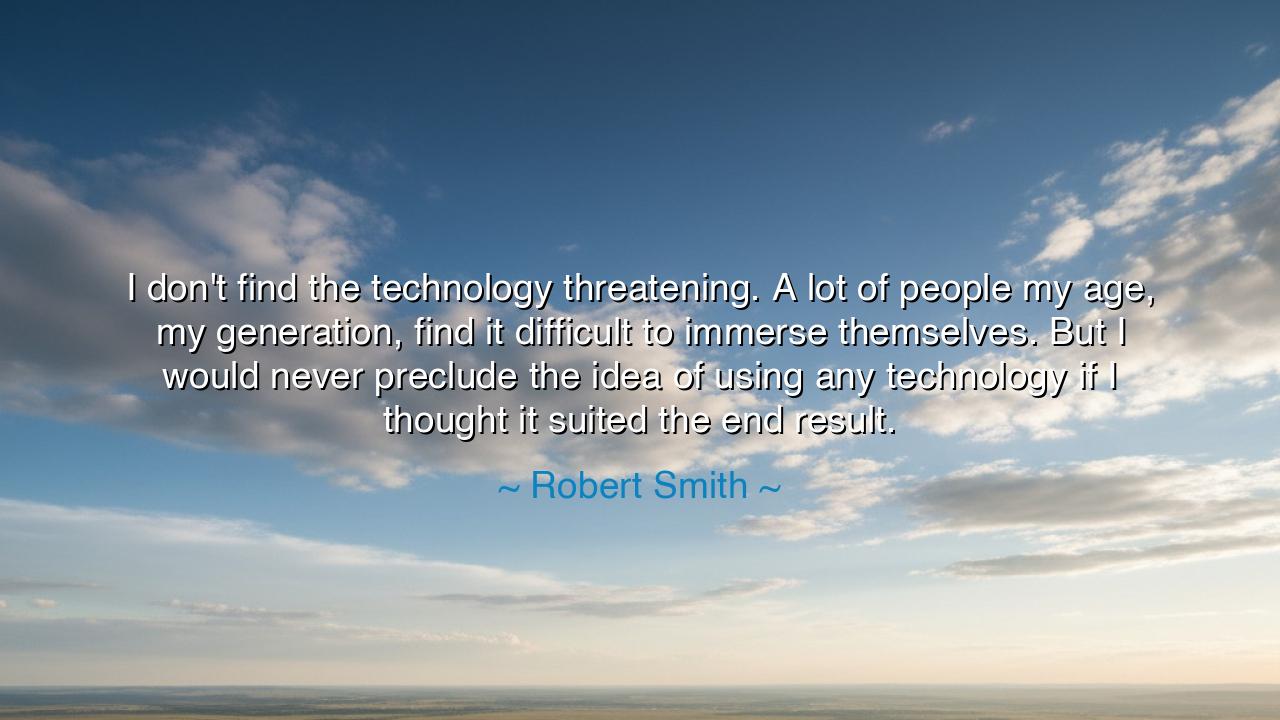
I don't find the technology threatening. A lot of people my age
I don't find the technology threatening. A lot of people my age, my generation, find it difficult to immerse themselves. But I would never preclude the idea of using any technology if I thought it suited the end result.






"I don't find the technology threatening. A lot of people my age, my generation, find it difficult to immerse themselves. But I would never preclude the idea of using any technology if I thought it suited the end result." – Robert Smith
In an age where technology is often seen as a force that changes the very fabric of human life, Robert Smith offers us a perspective that is both open-minded and pragmatic. He speaks not of fear or resistance to new technologies, but of a willingness to engage with them if they serve a greater purpose. His words reveal a profound truth: technology, in and of itself, is neither good nor bad; it is a tool—one that can be wielded for creative and productive ends when used with intent. To Smith, technology is not something to be feared or avoided, but something to be embraced if it helps to achieve a worthy goal. This wisdom echoes across the ages, reminding us that adaptability and pragmatism are key to navigating the complexities of the world.
In the ancient world, philosophers often wrestled with the same fundamental question: how should humanity relate to the tools and innovations they create? Socrates, for instance, questioned the value of the written word. Though writing had the potential to preserve knowledge and pass it on to future generations, Socrates feared that writing might diminish the ability to think critically, as it encouraged people to rely on external tools rather than cultivate the power of their own memory and reasoning. Yet, even Socrates understood that every new tool has its place. He simply challenged others to consider its use carefully. Similarly, Smith’s words reflect a philosophy of balance, where the purpose and intent behind using technology are more important than the technology itself.
In the realm of ancient innovation, the Romans are often seen as masters of technology. Their advancements in engineering, like the construction of aqueducts and roads, transformed the ancient world and connected the empire in ways that were previously unimaginable. Yet, these innovations were not without their critics. Cato the Elder, a Roman statesman and soldier, was wary of excess and luxury, believing that reliance on certain technologies and comforts could erode the virtue and discipline of the Roman people. Cato’s resistance, though rooted in a concern for societal values, was also a call to ensure that technology served the common good rather than becoming a crutch that weakened society. In this light, Smith’s approach to technology—one of consideration and adaptation—reflects the ancient ideal of using tools wisely, ensuring that they serve to enhance life without overshadowing it.
The medieval period saw a shift in the relationship between humanity and technology, especially with the advent of the printing press. Johannes Gutenberg’s invention was revolutionary, enabling the spread of knowledge and literacy in ways that had never been seen before. Yet, just as with every great innovation, there were doubts and resistances. Some scholars feared that the ease of access to written material would reduce the value of manual scholarship and careful study. But over time, the printing press proved itself a tool for empowering minds and fostering progress. This echoes Smith’s sentiment: technology is neither a foe nor a savior; it is a tool that must be used with purpose and intention, with an understanding of its role in the greater human experience.
Today, as digital technology has revolutionized how we communicate, create, and understand the world, many of us face the same question: how do we embrace the new without losing our sense of self and purpose? The key, as Smith suggests, is in understanding that technology should serve our end goals, not replace them. The creativity and self-expression that technology enables, when used properly, can lead to profound transformations in art, culture, and society. It is the intentionality behind its use that matters most. Just as Plato used the written word to advance his philosophical ideas, or the Romans constructed grand infrastructures to unite their empire, so too can we harness modern technology to enhance our own pursuits—whether in education, business, or personal development.
The lesson to be learned from Smith’s reflection is this: technology is neither a blessing nor a curse; it is a tool that, when used with discernment and purpose, can enrich and empower us. The key is not to be swept away by fear of the unknown or the temptation to resist change, but to understand how technology can be integrated into our lives to serve our deeper goals. In this way, we do not become slaves to progress, but masters of it, using it to enhance our humanity rather than diminish it.
In practical terms, we must approach new technologies with an open mind, much like Smith, considering how they can help us achieve our higher purposes. Let us embrace the tools that advance our goals, but always keep in mind the intentions behind their use. Whether it is a new device, platform, or system, the real power of technology lies in its purposeful application. By using it in ways that align with our values and aspirations, we create a world where technology serves humanity, rather than the other way around. Just as ancient innovators shaped their societies with the tools they had, so too can we shape our future with the tools we create today.






AAdministratorAdministrator
Welcome, honored guests. Please leave a comment, we will respond soon